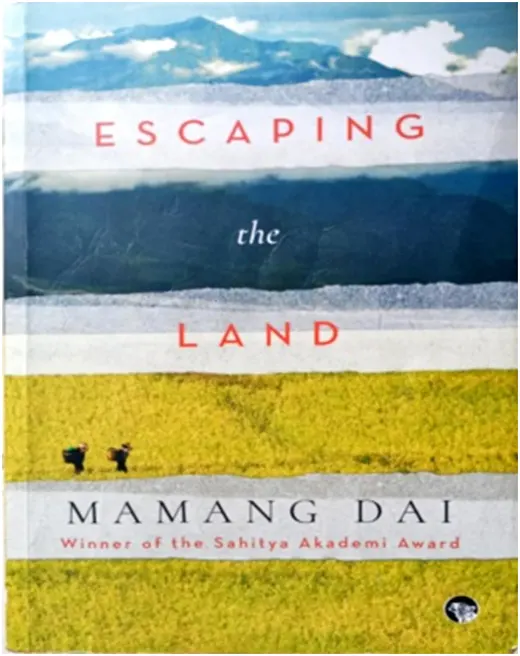“What is the past of Arunachal Pradesh?”
Escaping the Land
By Mamang Dai
Speaking Tiger, 2021
Pages: 303
Price: 599
[ Yater Nyokir ]
The history of Arunachal Pradesh is an amalgamation of myths, inter-tribe feuds, slavery, colonial intrusion, and administrative policies. It is a complicated saga of social and cultural transition.
Mamang Dai is a historical conscious writer. Her engagement with history can be seen in her fictions. Engaging in fact, fiction and oral memories she revives and chronologies the history of Arunachal Pradesh in her fictions.
Dai dramatizes the past by intricately unraveling the stories of those men and women, who witnessed the effects of historical events in their lives. She excavated the social, cultural and political history of Arunachal Pradesh in her latest novel Escaping the Land; in doing so she adds to our understanding of the obscure past and chaotic present of Arunachal Pradesh.
Dai’s ‘Escaping the Land’ divided into four books narrates the historical journey of transition from NEFA to Arunachal Pradesh. The book is compact with the variegated occurrence of the past, like the Komsing case of 1911, the Aching Mori incident of 1953, the Chinese aggression of 1962, the liberation of Bangladesh in 1972, and Arunachal Pradesh’s transition from a union territory to a full-fledged statehood in 1987.
History focuses on events where individual and private experiences are often ignored but Dai in introspective mode gives space to ordinary people’s actual experiences, concerns, and challenges through major characters in the novels. It reveals the effects of these historical events in the lives of commoners and helps the reader to speculate to know ‘what really happened.’
Lipun, a junior government official depicts the hardship of a government official serving in the Indian Frontier Administrative service during NEFA days. Such officials were posted in the outpost to maintain the positive hold of the government. It took months of foot march through the enormous jungle to reach the posted place along with lurking fear of being attacked by wild animals and agitated tribals. But the zeal and patriotism of those trailblazer officials for their land and people laid the foundation for today’s Arunachal.
The cultural history of the tribals of Arunachal Pradesh can be traced only through their oral memory. These collective memories are in the form of myths and legends that are expressed as a ‘story of origin’ in the Adi community. It constitutes the cultural history of Arunachal Pradesh.
Dai employs her critically acclaimed skill of imagination to retrieve the cultural history of the Adi community in the novel. Dai narrates the story of ‘Kiine Naane’, the earth mother and ‘Nyanyi Mete,’ the celestial Aunt of humans.
Adis have great faith in shamanism. They believe shamans can cure the sick, communicate with the spirit world, and bring the dead soul back. Dai showcases this cultural belief through the character of the Rainman, a shaman who could bring rain, turn into a tiger and make dry rock weep with his magical power.
Beads are a significant part of tribal culture. In the Adi community tadoks, precious beads are the symbol of wealth. The acquisition of beads by man has a story. They believed that their spirit wives or lover bestowed beads to men a long time ago. Men sacrifice beasts like mithuns, cattle, pigs and fowl as an offering to honour the supernatural entity for their favour upon them.
The story of a man from the Daji clan of Sirkung who was bestowed with tadok, by his spirit lover allows us to understand the history of the origin of beads in Adi folk belief.
Inter-tribal war, inter-village war, inter-clan war and the system of slavery was widespread occurrence in the past. War and feuds were fought to establish the power and strength of a particular tribe or clan over others. In such wars and feuds, the victorious marauders take the men and women of subjugated tribes or clans as slaves to work for the tribe or clan that owned them.
Dai conjured up the past with imagination and depicts the lived experience of passive victims of the slavery system.
She writes, “Years passed. The captive men died. Their wives succumbed to disease and despair and the new generation of men adopted the clan title of their owner…They had no memory of the places they had been taken from…The thought of running away never crossed their minds. Where would they run to, and for what? Life was food and breath and that was all there was.”
However, the practice of the slavery system is now abolished in Arunachal Pradesh. Dai, a historical writer sheds light on a particular period to attack the evil practices of the slavery system while doing so she also sketches the social history of Arunachal Pradesh in her novel.
A large part of the novel is devoted to portraying the political history of Arunachal Pradesh. Through the fictitious character of political leaders, like Lutor, Tanik, Aohun and Rasa the novel paints a vivid picture of the present state of political turmoil which is an outcome of the apathy and insensitivity of political regimes in the past. Dai provides a deep insight into the burning issues of insurgency and refugees in the state.
Dai by putting imaginary people in real situations evokes the unmapped and mapped history of Arunachal Pradesh. Interweaving fact and fiction she humanizes the history of Arunachal Pradesh in Escaping the Land. Arunachal’s past, particularly its colonial and postcolonial history is intricately interwoven with the history of the nation though this has been neglected in political discourse for a long time. Dai has painstakingly unearthed historical memories through oral narratives and historical dates through archival records to document the landmark events that have shaped present-day Arunachal Pradesh. The fictional overtone of the novel does not diminish the historical sense of the narrative. Escaping the Land is one such momentous effort in the oeuvre of Mamang Dai. (Nyokir is a member of Arunachal Pradesh Literary Society)



